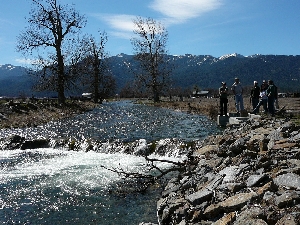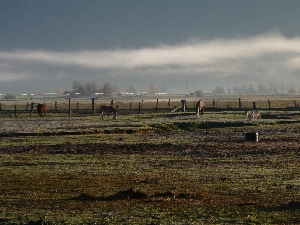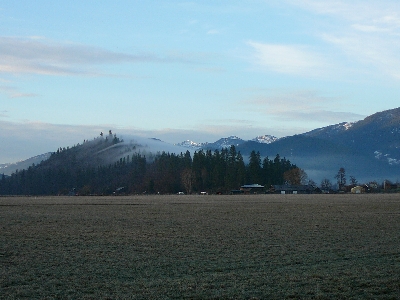Scott Valley
2023/2024 SVIHM Materials:
- February 14, 2024 SVIHM Workshop: video recording, slides
- Scott Valley Integrated Hydrologic Model: SVIHM-2018 and Scenario Development, Final Report to North Coast Regional Water Board, December 2023 (includes the below)
- SVIHM Scenario Updates 2022 w/ curtailment and unimpaired scenarios (compared to 2017 CDFW instream flow table and 2021 emergency regulation instream flow table)
- 11/22/2023: updated explanation slides, improved graphical presentation of percentile graphics, otherwise same scenario results
- SVIHM Scenario Updates 2022 w/ curtailment and unimpaired scenarios (compared to 2017 CDFW instream flow table and 2021 emergency regulation instream flow table)
- SWRCB October 6, 2023 Workshop presentation (includes two variable curtailment date scenarios)
- SWRCB Draft Emergency Order: UC Davis Comments, October 16, 2023
- Scott Valley GSP Appendix 4A - SVIHM Scenario
2021 Groundwater Sustainability Plans:
- Scott Valley GSP, December 2021
- Shasta Valley GSP, December 2021
- Butte Valley GSP, December 2021
Journal Articles:
- Kouba, C. and T. Harter, 2024. Seasonal prediction of end-of-dry-season watershed behavior in a highly interconnected alluvial watershed in northern California, Hydrol. Earth Syst. Sci., 28, 691–718, https://doi.org/10.5194/hess-28-691-2024 (open access)
- Tolley, D., L. Foglia, T. Harter, 2019. Sensitivity Analysis and Calibration of an Integrated Hydrologic Model in an Irrigated Agricultural Basin With a Groundwater-Dependent Ecosystem. Water Resour. Res., doi:10.1029/2018WR024209 (open access)
- NOTE: The above article includes a full update to the 2018 version of the Scott Valley Integrated Hydrologic Model, SVIHM, with embedded links to data and software sources.
-
Cantor, A., D. Owen, T. Harter, N. G. Nylen, and M. Kiparsky, 2018. Navigating Groundwater-Surface Water Interactions under the Sustainable Groundwater Management Act, Center for Law, Energy & the Environment, UC Berkeley School of Law, Berkeley, CA. 50 pp., https://doi.org/10.15779/J23P87
- Owen, D., A. Cantor, N. Green Nylen, T. Harter, and M. Kiparsky, 2019. California groundwater management, science-policy interfaces, and the legacies of artificial legal distinctions. Env. Res. Lett. 14(4). https://doi.org/10.1088/1748-9326/ab0751
-
Foglia, L., J. Neuman, D.G. Tolley, S.B. Orloff, R.L. Snyder, and T. Harter, 2018. Modeling guides groundwater management in a basin with river-aquifer interactions. California Agriculture 72(1):84-95.
- Foglia, L., A. McNally, and T. Harter, 2013. Coupling a spatio-temporally distributed soil water budget with stream-depletion functions to inform stakeholder-driven management of groundwater-dependent ecosystems. Water Resour. Res. 49:7292-7310, doi:10.1002/wrcr.20555 (open access).
- Supplemental Material: Estimating Streamflow into Scott Valley
Reports and Online Webinars:

Figure 1: Water level hydrographs for currently and recently active wells in the Scott Valley water level monitoring program, 2006 through 2024.

Figure 2: 2020/21 (green), 2021/22 (red), 2022/23 (dark blue), and 2023/24 (light blue) monthly average depth to groundwater (ft) in "Valley Floor" wells of the Scott Valley monitoring network (all shown as dashed lines). Solid lines (same color scheme) show the streamflow reading at the USGS Ft. Jones gage on the day of well water level sampling (usually sometime in the second half of the month). Note: May 2023 stream flow was above 1,000 cfs throughout the month (between 1,100 cfs and 3,100 cfs). On March 29, 2024 and June 3, 2024 (May measurement), flow was also just above 1,000 cfs.
Overall. groundwater levels follow the seasonal variations of streamflow and - very generally speaking - in years with higher flows, groundwater levels are higher. There are exceptions that are also relevant to the design of the Scott Valley GSP, for example: At the end of October 2021, four days after an unusual atmospheric river provided enough rain to connect the entire length of the Scott River and generated a peak flow of over 800 cfs, the average depth to water level in Valley Floor wells was 15.9 ft. In contrast, late November 2020 featured more shallow average depth to water level of 15.5 ft (the first major 2020 rain occurred just before Thanksgiving). Despite the higher aquifer water levels at the end of November 2020 (when compared to late October 2021), the Scott River would not connect until more storms occurred in mid-December. This shows that water levels are difficult to interpret with respect to inferring instream flows.
- Scott Valley Integrated Hydrologic Model: SVIHM-2018 and Scenario Development, Final Report to North Coast Regional Water Board, December 2023 (12/2023)
- Reducing agriculture's groundwater pumping impact on streams (Dissertation Defense Seminar by Claire Kouba, 2022)
- Summary of the Scott Valley private water level monitoring program, 2006-2018.
- roundwater-dependent ecosystems: Scott Valley (UC Davis webinar, 2015)
- Understanding Groundwater-Surface Water Interactions (AGI webinar, 2015)
- Dynamics of Scott Valley water table surface (movie), 1953-2015
- Scott Valley Pumping Test Report (2014)
- Scott Valley Integrated Hydrologic Model: Data Collection, Analysis, and Soil Water Budget (4/2013)
- Scott Valley Integrated Hydrologic Model: Data Collection, Analysis, and Soil Water Budget Appendix A (4/2013)
- Scott Valley Community Groundwater Study Plan (2008)
- Comments provided on the draft plan, October 2007 (4.5 MB pdf file)
- or: same comments, but including 2005 TMDL Draft Comments by QVIC

Principal Investigator:
Thomas Harter [contact for technical comments/questions]
The Scott Valley is an agricultural groundwater basin in Northern California, within the Scott River watershed and part of the much larger Klamath Basin watershed straddling the California-Oregon border. The Scott River provides important habitat for salmonid fish, including spawning and rearing habitat for coho and fall-run Chinook salmon and steelhead trout. Sufficient flows at adequately low temperatures during summer, for rearing, and fall, for spawning, are critical for healthy fish habitat in the mainstem and tributaries.
We are currently working with the State Water Resources Control Board to update the Scott Valley Integrated Hydrologic Model (SVIHM). The updated version will tackle several improvements:
- The upper watershed above the Valley floor (uphill from the alluvial groundwater basin) will be represented through PRMS, a USGS software that represents the physical watershed processes. In prior versions of SVIHM, the upper watershed was represented through a statistical model of daily tributary inflows to the valley floor.
- The Discharge Zone representation is updated using a newly developed MODFLOW package DRNO, which routes "drain water" (i.e., spring water) into specific tributary/stream locations
- The alluvial aquifer heterogeneity will reflect not only the sub-regional zoning, but also account for well-log stratigraphy and the 2021 aerial eletromagnetic (AEM) survey of subsurface stratigraphy, implemented by CA DWR
- The streamflow routing package will operate on daily varying inflows from tributaries (instead of monthly average inflows)
- Water rights point of diversion and point of use will be mapped out, using WEAP
- A new model calibration will take advantage of additional data collected between 2011 and 2024, not included in SVIHM-2011 (Tolley et al., 2019) and SVIHM-2018 (Harter et al., 2023).
- The model structure will be simplified for developing new scenarios.
From 2019 to 2022, we have been working with the Groundwater Sustainability Agency for Scott Valley, the Siskiyou County Flood Control District, and its Technical Advisory Council, to develop a Groundwater Sustainability Plan under the regulations of the Sustainable Groundwater Management Act, passed by the California legislature in 2014. These efforts, summarized in the SVIHM-2018 report (Harter et al., 2023) are following significant prior technical development by UC Cooperative Extension and its groundwater program in the Scott Valley:
The April 2013 Scott Valley Integrated Hydrologic Model data report and the peer-reviewed publication by Foglia et al. (2013) present the data assembled and the methods used for data analysis and data modeling for SVIHM-2011. The report includes precipitation data analysis, streamflow data analysis and modeling, geology and groundwater data review and analysis, evapotranspiration and soils data analysis, and preparation of relevant watershed, land use, topography, and irrigation data. The data collection and analysis efforts culminate in the development of a spatio-temporally distributed soil water budget model for the Scott Valley. The soil water budget model is used to determine spatially and temporally varying groundwater pumping rates, surface water diversion rates, and groundwater recharge across the groundwater basin. The spatial resolution of the soil water budget model is by individual fields (land use polygons). Temporal discretization is in daily time steps for the period from October 1, 1990 to September 30, 2011. This period includes several dry years, average years, and wet year periods. Further model developments for groundwater and surface water modeling components, and improvements to the Soil Water Budget model components of SVIHM are reported in Foglia et al. (2018). The calibration of SVIHM-2011 is documented in Tolley et al. (2019).


